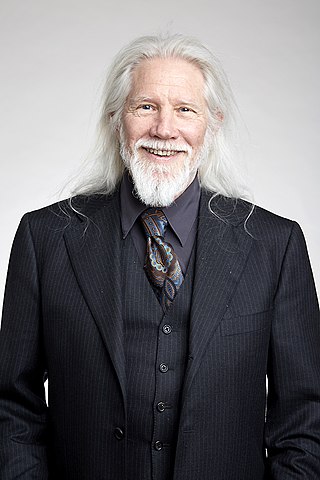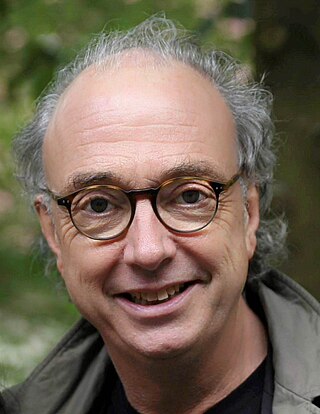Related Research Articles
Elliptic-curve cryptography (ECC) is an approach to public-key cryptography based on the algebraic structure of elliptic curves over finite fields. ECC allows smaller keys compared to non-EC cryptography to provide equivalent security.

In cryptography, encryption is the process of encoding information. This process converts the original representation of the information, known as plaintext, into an alternative form known as ciphertext. Ideally, only authorized parties can decipher a ciphertext back to plaintext and access the original information. Encryption does not itself prevent interference but denies the intelligible content to a would-be interceptor.

Daniel Julius Bernstein is an American German mathematician, cryptologist, and computer scientist. He is a visiting professor at CASA at Ruhr University Bochum, as well as a research professor of Computer Science at the University of Illinois at Chicago. Before this, he was a professor in the department of mathematics and computer science at the Eindhoven University of Technology.

David Lee Chaum is an American computer scientist, cryptographer, and inventor. He is known as a pioneer in cryptography and privacy-preserving technologies, and widely recognized as the inventor of digital cash. His 1982 dissertation "Computer Systems Established, Maintained, and Trusted by Mutually Suspicious Groups" is the first known proposal for a blockchain protocol. Complete with the code to implement the protocol, Chaum's dissertation proposed all but one element of the blockchain later detailed in the Bitcoin whitepaper. He has been referred to as "the father of online anonymity", and "the godfather of cryptocurrency".

Bailey Whitfield 'Whit' Diffie, ForMemRS, is an American cryptographer and mathematician and one of the pioneers of public-key cryptography along with Martin Hellman and Ralph Merkle. Diffie and Hellman's 1976 paper New Directions in Cryptography introduced a radically new method of distributing cryptographic keys, that helped solve key distribution—a fundamental problem in cryptography. Their technique became known as Diffie–Hellman key exchange. The article stimulated the almost immediate public development of a new class of encryption algorithms, the asymmetric key algorithms.
NTRU is an open-source public-key cryptosystem that uses lattice-based cryptography to encrypt and decrypt data. It consists of two algorithms: NTRUEncrypt, which is used for encryption, and NTRUSign, which is used for digital signatures. Unlike other popular public-key cryptosystems, it is resistant to attacks using Shor's algorithm. NTRUEncrypt was patented, but it was placed in the public domain in 2017. NTRUSign is patented, but it can be used by software under the GPL.
Brian A. LaMacchia is a computer security specialist.

Maria Margaret Klawe is a computer scientist and the fifth president of Harvey Mudd College. Born in Toronto in 1951, she became a naturalized U.S. citizen in 2009. She was previously Dean of the School of Engineering and Applied Science at Princeton University. She is known for her advocacy for women in STEM fields.

CrypTool is an open-source project that is a free e-learning software for illustrating cryptographic and cryptanalytic concepts. According to "Hakin9", CrypTool is worldwide the most widespread e-learning software in the field of cryptology.
Lattice-based cryptography is the generic term for constructions of cryptographic primitives that involve lattices, either in the construction itself or in the security proof. Lattice-based constructions are currently important candidates for post-quantum cryptography. Unlike more widely used and known public-key schemes such as the RSA, Diffie-Hellman or elliptic-curve cryptosystems — which could, theoretically, be defeated using Shor's algorithm on a quantum computer — some lattice-based constructions appear to be resistant to attack by both classical and quantum computers. Furthermore, many lattice-based constructions are considered to be secure under the assumption that certain well-studied computational lattice problems cannot be solved efficiently.

Cryptography, or cryptology, is the practice and study of techniques for secure communication in the presence of adversarial behavior. More generally, cryptography is about constructing and analyzing protocols that prevent third parties or the public from reading private messages. Modern cryptography exists at the intersection of the disciplines of mathematics, computer science, information security, electrical engineering, digital signal processing, physics, and others. Core concepts related to information security are also central to cryptography. Practical applications of cryptography include electronic commerce, chip-based payment cards, digital currencies, computer passwords, and military communications.
In cryptography, post-quantum cryptography (PQC) refers to cryptographic algorithms that are thought to be secure against a cryptanalytic attack by a quantum computer. The problem with currently popular algorithms is that their security relies on one of three hard mathematical problems: the integer factorization problem, the discrete logarithm problem or the elliptic-curve discrete logarithm problem. All of these problems could be easily solved on a sufficiently powerful quantum computer running Shor's algorithm.

Peter Landrock is a Danish cryptographer and mathematician. He is known for his contributions to data encryption methods and codes. Landrock has been active since the 1970s as research scientist and faculty member for Cambridge University and the University of Aarhus and others, and was active for Microsoft and Cryptomathic. He has been visiting professor at Oxford University, Leuven University and Princeton University.
Post-Quantum Cryptography Standardization is a program and competition by NIST to update their standards to include post-quantum cryptography. It was announced at PQCrypto 2016. 23 signature schemes and 59 encryption/KEM schemes were submitted by the initial submission deadline at the end of 2017 of which 69 total were deemed complete and proper and participated in the first round. Seven of these, of which 3 are signature schemes, have advanced to the third round, which was announced on July 22, 2020.

Yael Tauman Kalai is a cryptographer and theoretical computer scientist who works as a Senior Principal Researcher at Microsoft Research New England and as an adjunct professor at MIT in the Computer Science and Artificial Intelligence Lab.
In cryptographic protocol design, cryptographic agility or crypto-agility is the ability to switch between multiple cryptographic primitives.

Johannes Alfred Buchmann is a German computer scientist, mathematician and professor emeritus at the department of computer science of the Technische Universität Darmstadt.

The Technology Innovation Institute (TII) is an Abu Dhabi government funded research institution that operates in the areas of artificial intelligence, quantum computing, autonomous robotics, cryptography, advanced materials, digital science, directed energy and secure systems. The institute is a part of the Abu Dhabi Government’s Advanced Technology Research Council (ATRC).

Hugo Krawczyk is an Argentine-Israeli cryptographer best known for co-inventing the HMAC message authentication algorithm and contributing in fundamental ways to the cryptographic architecture of central Internet standards, including IPsec, IKE, and SSL/TLS. In particular, both IKEv2 and TLS 1.3 use Krawczyk’s SIGMA protocol as the cryptographic core of their key exchange procedures. He has also contributed foundational work in the areas of threshold and proactive cryptosystems and searchable symmetric encryption, among others.
References
- 1 2 Melissa Chase, Microsoft Research , retrieved 2018-11-10
- ↑ "Melissa Chase, Harvey Mudd College Mathematics 2003", Senior Thesis archives, Harvey Mudd College Mathematics Department, retrieved 2018-11-10
- ↑ Picnic: A Family of Post-Quantum Secure Digital Signature Algorithms, Microsoft Research , retrieved 2018-11-10
- ↑ "Round 1 Submissions", Post-Quantum Cryptography, National Institute of Standards and Technology, 3 January 2017, retrieved 2018-11-10
- ↑ Real World Crypto 2018 , retrieved 2018-11-10